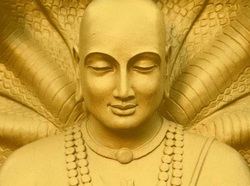WHAT IS YOGA?

The word yoga comes from the Sanskrit root “yuj” which means to bind or unite. Yoga is therefore an experience of inner development that integrates body, mind and soul.
The ultimate goal of yoga practice is the liberation and realization of the Self and, on a spiritual level, the union of consciousness with the Supreme (state of samadhi).
More than 2,500 years ago, Sage Patanjali wrote down the teachings of the Rishis (enlightened masters) hitherto transmitted orally and defined them in his Yoga Sutras: “Yogaschitta vritti nirodhah”, meaning “Yoga is the cessation of the fluctuations of the mind” .
There are eight stages to allow one to reach the state of Samadhi or pure consciousness, yoga's ultimate goal. These are called the Ashtanga, the pillars of yoga.
Yama: moral rules of society - non-violence, non-theft, non-covetousness, truth, moderation in desires
Niyama: personal discipline - purity, study of self and scriptures, charity and modesty
Asana: postures - stability, curing of diseases and enlightenment of the whole being
Pranayama: breath control (prana = vital energy)
Pratyahara: withdrawal of the senses
Darhana: concentration
Dhyana: meditation
Samadhi: liberation and realization of the Self (loss of one's own identity and fusion with the Supreme).
The practice of yoga helps building up strength and health for the body and mind. Only then we can find balance within ourselves and face the vicissitudes of life with serenity and detachment.
The ultimate goal of yoga practice is the liberation and realization of the Self and, on a spiritual level, the union of consciousness with the Supreme (state of samadhi).
More than 2,500 years ago, Sage Patanjali wrote down the teachings of the Rishis (enlightened masters) hitherto transmitted orally and defined them in his Yoga Sutras: “Yogaschitta vritti nirodhah”, meaning “Yoga is the cessation of the fluctuations of the mind” .
There are eight stages to allow one to reach the state of Samadhi or pure consciousness, yoga's ultimate goal. These are called the Ashtanga, the pillars of yoga.
Yama: moral rules of society - non-violence, non-theft, non-covetousness, truth, moderation in desires
Niyama: personal discipline - purity, study of self and scriptures, charity and modesty
Asana: postures - stability, curing of diseases and enlightenment of the whole being
Pranayama: breath control (prana = vital energy)
Pratyahara: withdrawal of the senses
Darhana: concentration
Dhyana: meditation
Samadhi: liberation and realization of the Self (loss of one's own identity and fusion with the Supreme).
The practice of yoga helps building up strength and health for the body and mind. Only then we can find balance within ourselves and face the vicissitudes of life with serenity and detachment.
